- 1. Understanding Voice-Activated Oral Care Technology
- 2. Benefits of Voice-Activated Assistants for Oral Care
- 3. Selecting the Right Voice-Activated Assistant for Oral Care
- 4. The Future of Oral Health: Voice-Activated Assistants and Beyond
- 5. Voice-Activated Oral Care Assistants: Key Takeaways
- 6. How Voice-Activated Assistants Can Aid Oral Care: Your FAQs Answered
The integration of technology into everyday life has revolutionized how we approach personal care, including oral hygiene. Among these advancements, voice-activated assistants have emerged as valuable tools, offering unique benefits that can significantly enhance oral care routines, especially for individuals facing mobility or dexterity challenges.
This guide explores the role of voice-activated assistants in oral hygiene, highlighting how these technologies can make dental care more accessible and effective.
Understanding Voice-Activated Oral Care Technology
Voice-activated assistants, powered by AI, are becoming integral parts of our homes, assisting with everything from playing music to managing schedules. In the realm of oral care, these devices can control smart toothbrushes, set reminders for brushing and flossing, and even provide real-time feedback on brushing techniques.
Recent studies suggest that integrating voice technology into oral care routines can lead to more consistent hygiene practices. For instance, a pilot study found that participants who used a voice-activated toothbrush reminder were more likely to adhere to recommended brushing times.
Benefits of Voice-Activated Assistants for Oral Care
Enhanced Accessibility: Ideal for seniors or those with limited mobility, voice commands can activate toothbrushes, reducing the need for manual interaction.
Personalized Care: Some smart toothbrushes connected to voice assistants offer personalized feedback on brushing habits, helping users improve their technique over time.
Encouragement and Reminders: Setting up voice-activated reminders ensures regular oral care, promoting a healthy routine.
Educational Insights: Users can receive real-time tips and oral health education via voice assistants, enhancing the effectiveness of daily routines.
Selecting the Right Voice-Activated Assistant for Oral Care
Selecting the optimal voice-activated assistant for oral care is a nuanced process that hinges on several key factors, each contributing to a seamless and effective oral hygiene routine. As we venture into this digital age, where technology increasingly intersects with daily life, the importance of choosing a device that aligns with personal needs and preferences cannot be overstated. Here, we’ll navigate the criteria to consider when choosing your voice-activated assistant for oral care, highlighting the capabilities of popular devices such as Amazon Echo and Google Home.
Compatibility: The Foundation of a Smart Oral Care Routine
The cornerstone of integrating voice-activated technology into your oral care regimen is ensuring compatibility between the assistant and your existing devices. This compatibility extends beyond just connecting to your home Wi-Fi network—it encompasses the ability to seamlessly interact with smart toothbrushes and other oral care gadgets you might use. Before making a selection, verify that the voice assistant supports the specific brands and models of smart toothbrushes you prefer, ensuring a harmonious digital ecosystem in your bathroom.
Ease of Use: Simplifying Oral Hygiene
A voice-activated assistant should simplify your oral care routine, not complicate it. This ease of use is manifested in how intuitively you can interact with the device. Can it understand and respond to your commands without repetitive prompts? Is setting up oral care reminders or accessing specific applications a straightforward process? Devices like Amazon Echo and Google Home excel in user-friendliness, offering intuitive setup processes and natural language recognition that minimize the learning curve for all users, regardless of their technological savviness.
Feature-Rich: Enhancing Your Oral Care Experience
The specific features offered by a voice-activated assistant can significantly enhance your oral hygiene practice. Look for devices that offer a range of functionalities tailored to health and wellness. This might include the ability to set multiple types of reminders—not just for brushing and flossing but also for dentist appointments and when to replace your toothbrush head. Additionally, some assistants offer educational content or the ability to connect with healthcare professionals, providing valuable insights and advice on maintaining optimal oral health.
Leading the Pack: Amazon Echo and Google Home
Among the myriad options available, Amazon Echo and Google Home stand out as frontrunners in the realm of voice-activated assistants for oral care. These devices offer extensive compatibility with a variety of smart toothbrushes and oral care applications, ensuring you can find the perfect match for your needs. Their user-friendly interfaces and robust feature sets make them ideal companions in your quest for a healthier smile, providing both the convenience and technological edge needed to elevate your oral hygiene routine.
| Feature | Description | Impact on Oral Care |
|---|---|---|
| Hands-Free Operation | Control devices without physical touch. | Enhances accessibility for individuals with mobility issues. |
| Custom Reminders | Set personalized oral care reminders. | Improves adherence to regular brushing and flossing schedules. |
| Educational Content | Provides instant access to oral health tips. | Increases awareness and knowledge about dental hygiene practices. |
| Integration with Smart Devices | Connects with smart toothbrushes and health apps. | Allows for monitoring and improving brushing techniques. |
| Tele-Dentistry Support | Facilitates virtual dental consultations. | Makes professional dental advice more accessible. |
The Future of Oral Health: Voice-Activated Assistants and Beyond
As we stand on the brink of a new era in oral healthcare, the evolution of voice-activated assistants signals a future where technology and health converge to create unprecedented opportunities for enhancement and innovation in dental care. This section delves into the potential future developments in voice technology and its implications for oral health, painting a picture of what lies ahead for individuals seeking to maintain their dental hygiene through cutting-edge solutions.
Predictive Health Insights Through Voice Analysis
Emerging research suggests that voice-activated technology might soon offer more than just operational assistance; it could provide predictive insights into oral and overall health. Advanced algorithms are being developed to analyze voice patterns, potentially identifying early signs of oral health issues or even systemic health problems that have oral manifestations. Imagine receiving a timely reminder from your voice assistant to book a dental check-up, based on subtle changes in your speech that could indicate a developing condition.
Integration with Tele-Dentistry Services
The integration of voice-activated assistants with tele-dentistry platforms is on the horizon. This synergy could revolutionize how we access dental consultations, making it possible to receive professional advice without leaving home. Users could ask their voice assistant to schedule virtual appointments, receive reminders for these sessions, and even conduct preliminary symptom assessments through voice interactions, streamlining the process of obtaining dental care.
Customized Oral Health Education
Future iterations of voice-activated oral care assistants could become personalized oral health educators. By gathering data on users’ habits and preferences, these assistants could provide customized advice on improving oral hygiene routines, suggest specific products based on individual needs, and offer motivational support to maintain healthy practices. This personalized approach could significantly impact public health by providing tailored education at scale, addressing preventable oral health issues before they escalate.
Seamless Integration with Smart Home Systems
Looking ahead, voice-activated oral care assistants are expected to become seamlessly integrated with broader smart home ecosystems. This integration could enable users to manage all aspects of their oral health through a centralized system, from monitoring water usage while brushing to adjusting the lighting in the bathroom for optimal visibility during oral care routines. The convenience and efficiency of such a fully integrated approach would further encourage consistent, effective oral hygiene practices.
Voice-Activated Oral Care Assistants: Key Takeaways
The integration of voice-activated assistants into the realm of oral hygiene marks a pivotal advancement in how we approach and manage our daily dental care routines. This innovation serves not just as a testament to technological progress but as a transformative tool that democratizes oral health care, making it more accessible and tailored to individual needs. Here are the key takeaways that underscore the significance of voice-activated oral care assistants in today’s health-conscious society.
Enhancing Oral Care Accessibility
The introduction of voice-activated technology into oral hygiene routines heralds a new era of accessibility in dental care. For individuals facing challenges with manual dexterity, such as seniors or those with physical disabilities, voice commands serve as a bridge to independence, enabling them to engage in essential oral hygiene practices without the need for traditional brushing and flossing methods. This leap in accessibility not only fosters autonomy but also ensures that a wider audience can achieve and maintain optimal oral health with fewer barriers.
Customization at Your Command
One of the most compelling advantages of voice-activated oral care assistants is the unparalleled level of customization they offer. Through simple voice commands, users can adjust their oral hygiene routines to suit their specific needs, whether it’s setting reminders for brushing and flossing, adjusting the intensity of their smart toothbrush, or accessing personalized oral health tips. This customization goes beyond mere convenience; it allows for a more targeted approach to dental care, ensuring that each individual’s unique health requirements are met with precision and ease.
The core of what makes voice-activated oral care assistants truly transformative is their ability to empower users. By harnessing the power of innovative technology, individuals can take charge of their oral health in ways previously unimaginable. This empowerment stems from the confidence that comes with having control over one’s dental care routine and the assurance that technology is available to support their health goals. The impact of such empowerment extends beyond oral hygiene, fostering a sense of agency and independence that enriches overall well-being.
As we envision the future of oral health powered by voice technology, it’s clear that the potential extends far beyond convenience. The advancements in voice-activated assistants promise a future where oral care is more accessible, personalized, and integrated into our daily lives, empowering individuals to take proactive steps towards maintaining their dental health. By embracing these technologies, we open the door to a future where every voice command brings us closer to achieving optimal oral wellness, setting a new standard for health care in the digital age
How Voice-Activated Assistants Can Aid Oral Care: Your FAQs Answered
Can voice-activated assistants improve my brushing routine?
Yes, by setting reminders and providing tips, they can help you maintain a consistent and effective brushing routine.
Are these assistants compatible with any toothbrush?
While some features work with all toothbrushes, the best functionality is achieved with smart toothbrushes designed for integration.
How do voice-activated assistants help with flossing?
They can remind you to floss regularly and log your flossing habits, encouraging consistency.
Can I get dental health tips from my voice-activated assistant?
Yes, many assistants can provide instant oral health tips and answer questions about dental care.
Is it possible to schedule dentist appointments through a voice assistant?
Depending on the assistant’s capabilities and your dentist’s booking system, you might be able to schedule appointments directly.
Do voice assistants help monitor the health of my gums?
By integrating with smart devices, they can track brushing habits that impact gum health and suggest improvements.
Can children use voice-activated assistants for their oral care routines?
Absolutely, they can make oral care more engaging for children and help them learn good habits early.
Are voice-activated assistants expensive to use for oral care?
The cost varies, but many features are accessible with basic models of popular assistants like Amazon Echo or Google Home.
How do these assistants provide tele-dentistry support?
They can connect you with tele-dentistry platforms for virtual consultations and advice.
Can using a voice-activated assistant really make a difference in my oral health?
Yes, by fostering better habits, providing educational content, and making dental care more accessible, they can significantly improve your oral health.
References
- “The Trustworthiness of Voice Assistants in the Context of Healthcare Investigating the Effect of Perceived Expertise on the Trustworthiness of Voice Assistants, Providers, Data Receivers, and Automatic Speech Recognition” by Carolin Wienrich, Clemens Reitelbach, and Astrid Carolus. This study investigates the trustworthiness of voice assistants in the context of healthcare, emphasizing the importance of perceived expertise.
- “Voice Assistants for Therapeutic Support – A Literature Review” by Ingo Siegert, Matthias Busch, Susanne Metzner, and Julia Krüger2. This literature review assesses the usability of voice-based interaction in therapies in health care and compares technical and conversational implementations.
- “Feasibility of Incorporating Voice Technology and Virtual Assistants in the Management of Chronic Disease: Systematic Review” (author not specified). This systematic review discusses the feasibility of incorporating voice technology and virtual assistants in the management of chronic disease.
- “Combining augmented and virtual reality with voice-activated virtual assistants in the digital transformation of dental education: a scoping review”. This scoping review explores the potential of combining augmented and virtual reality with voice-activated virtual assistants in the digital transformation of dental education.
- “Voice Activated Personal Assistant: Acceptability of Use in the Elderly Population” (author not specified)5. This study assesses the acceptability of using voice-activated personal assistants in the elderly population.








